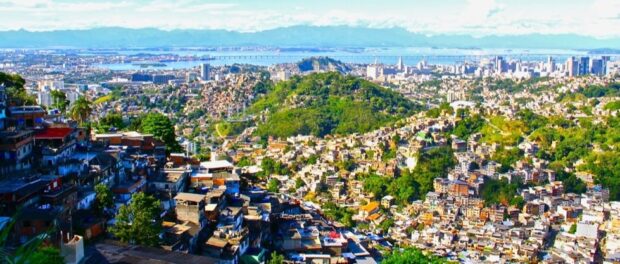
Our Resources for Journalists page is a collection of materials about Rio de Janeiro’s favelas and the city’s ongoing transformations. In its original version, the page was designed to facilitate productive reporting ahead of and during the 2016 Olympic and Paralympic Games. Since the Games, it has been updated to reflect the continued need for nuanced coverage of favelas that recognizes these communities’ qualities and opportunities alongside their challenges. The resources include must-know background information on favelas, food for thought on the challenges and responsibilities of reporting on these neighborhoods, overviews of and favela perspectives on urban policies, and thematic categories of articles aimed to inspire and inform your stories.
These resources have been developed through Catalytic Communities‘ 18 years of building networks among community leaders and activists, and our eight years of reporting on Rio’s favelas through RioOnWatch.org.
Explore the compilation of Resources for Journalists here.
Read RioOnWatch’s policy for reporting and working with journalists here.
Why is the work of international journalists so important?
Rio’s favelas are often portrayed as violent, crime-ridden, or impoverished, and labeled in English as “slums” or “shantytowns.” In reality, favelas are simply neighborhoods that emerged as an informal solution over a century ago to the unmet need for housing (one might have accurately used these terms in their founding years, though they are derogatory terms nonetheless), and which have since been established and developed with no outside or government regulation. The primarily brick and cement houses are built well and to last, with running water, electricity, garbage collection and Internet access, though of low quality due to their systemic historic exclusion by the authorities. During Brazil’s recent boom, 65% of favela residents were in Brazil’s middle class, while less than 1% are involved in drug trafficking. As the affordable housing stock in a city with severe inequality, Rio’s favelas are also home to samba, funk, and passinho, bustling entrepreneurship, racial and cultural diversity, a strong tradition of activism, and a burgeoning community media scene. For a deeper understanding, contact us for a copy of the chapter in Perspecta 50: Urban Divides entitled “Rio’s Favelas: The Power of Informal Urbanism.”
The image of favelas portrayed in the media matters because productive reporting enables productive policies, whereas lazy journalism can perpetuate policies that treat favelas as the dark side to be removed, ignored, or dealt with through violence. In particular, the international portrayal of favelas matters now, as the city of Rio strives to define itself and its priorities in the wake of the Olympic Games that dominated its development agenda for seven years.
Read more about international reporting on favelas in our 2016 analysis of favela portrayals in Rio’s mega-event years, and in our 2017 analysis comparing favela portrayals in eight global outlets and in articles written by favela journalists.
What is Catalytic Communities?
Catalytic Communities is an 18-year-old community planning and advocacy nonprofit working on-the-ground across hundreds of Rio’s favelas with local leaders and organizers. CatComm’s mission is to create models for effective integration between informal and formal settlements in cities across the globe, based on the experience of Rio de Janeiro. We believe the qualities of Rio’s favelas can inspire communities everywhere. CatComm is dedicated to improving the quality of life for all Rio de Janeiro residents by driving a more creative, inclusive and empowering integration between the city’s informal and formal communities, in which the city’s favelas are recognized for their heritage status and their residents fully served as equal citizens. This is done through a combination of education, research, training, strategic communications, technology, networks, advocacy, and participatory planning.
What is RioOnWatch?
RioOnWatch began in 2010 as CatComm’s program to bring visibility to Rio’s favela community voices and document the impacts of Rio’s pre-Olympic years on the city’s favelas. Since the 2016 Games, RioOnWatch.org continues to monitor Olympic legacies and human rights but focuses on the potential of favelas as sustainable communities, publishing community perspectives, solutions, policy proposals, and organizing strategies that embolden and empower this vision. The program works to grow the participation of community journalists in reporting on Rio’s transformations. We also dialogue with the mainstream and alternative press to engender a more accurate picture of favelas, their contributions to the city, and resident perspectives.
Contact us
We’re also available to offer further support and answer questions—email us at press@catcomm.org. CatComm’s Executive Director, urban planner Theresa Williamson (PhD), is also available for interviews.
